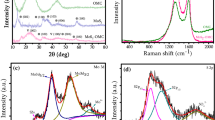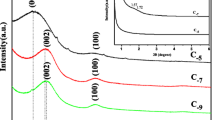Abstract
A space-confined synthesis method is employed for the preparation of a single-layer MoS2–boron doped ordered mesoporous carbon nanocomposite. A phenol-formaldehyde resin is used as carbon source to create a confined space for the formation of single-layer MoS2. The addition of pluronic F127, as a soft template, suppresses the stacking of MoS2 layers and makes the composite porous. The nanocomposite is characterized by scanning electron and transmission electron microscopy, X-ray diffraction, X-ray photoelectron spectroscopy and energy dispersive X-ray spectroscopy. The single-layer MoS2 sheets have a lateral size of about 5 nm and are uniformly embedded in the composite. They possess numerous active edge sites and display a strong synergistic effect with other components. The composite is modified on a glassy carbon electrode, followed by the electrochemical imprinting of theophylline, and the resulting electrode exhibits good electrochemical response to theophylline. The linear response range is 0.01–250 μM by differential pulse voltammetry, and the lower detection limit is 5 nM. It has been successfully applied to the determination of theophylline in spiked tea drink samples.

Single-layer MoS2–boron doped ordered mesoporous carbon nanocomposite has large surface area and high catalysis, when coupling with molecularly imprinted polymer the resulting electrode shows highly sensitive and selective response to theophylline.







Similar content being viewed by others
References
Jiang H, Ren DY, Wang HF, Hu YJ, Guo SJ, Yuan HY, Hu PJ, Zhang L, Li CZ (2015) 2D monolayer MoS2-carbon Interoverlapped superstructure: engineering ideal atomic Interface for Lithium ion storage. Adv Mater 27(24):3687–3695. https://doi.org/10.1002/adma.201501059
Zhang X, Zhao R, Wu Q, Li W, Shen C, Ni L, Yan H, Diao G, Chen M (2017) Petal-like MoS2 Nanosheets space-confined in hollow mesoporous carbon spheres for enhanced Lithium storage performance. ACS Nano 11(8):8429–8436. https://doi.org/10.1021/acsnano.7b04078
Dalila RN, Md Arshad MK, Gopinath SCB, Norhaimi WMW, Fathil MFM (2019) Current and future envision on developing biosensors aided by 2D molybdenum disulfide (MoS2) productions. Biosens Bioelectron 132:248–264. https://doi.org/10.1016/j.bios.2019.03.005
Yadav V, Roy S, Singh P, Khan Z, Jaiswal A (2019) 2D MoS2 -based nanomaterials for therapeutic, bioimaging, and biosensing applications. Small 15(1):e1803706. https://doi.org/10.1002/smll.201803706
Yoon J, Lee T, Bapurao GB, Jo J, Oh BK, Choi JW (2017) Electrochemical H2O2 biosensor composed of myoglobin on MoS2 nanoparticle-graphene oxide hybrid structure. Biosens Bioelectron 93:14–20. https://doi.org/10.1016/j.bios.2016.11.064
Govindasamy M, Chen SM, Mani V, Devasenathipathy R, Umamaheswari R, Joseph Santhanaraj K, Sathiyan A (2017) Molybdenum disulfide nanosheets coated multiwalled carbon nanotubes composite for highly sensitive determination of chloramphenicol in food samples milk, honey and powdered milk. J Colloid Interface Sci 485:129–136. https://doi.org/10.1016/j.jcis.2016.09.029
Asadi M, Kumar B, Liu C, Phillips P, Yasaei P, Behranginia A, Zapol P, Klie RF, Curtiss LA, Salehi-Khojin A (2016) Cathode based on molybdenum disulfide Nanoflakes for Lithium–oxygen batteries. ACS Nano 10(2):2167–2175. https://doi.org/10.1021/acsnano.5b06672
Shen M, Ruan C, Chen Y, Jiang C, Ai K, Lu L (2015) Covalent entrapment of cobalt–iron sulfides in N-doped mesoporous carbon: extraordinary bifunctional Electrocatalysts for oxygen reduction and evolution reactions. ACS Appl Mater Interfaces 7(2):1207–1218. https://doi.org/10.1021/am507033x
Hao L, Yu J, Xu X, Yang L, Xing ZP, Dai Y, Sun Y, Zou JL (2017) Nitrogen-doped MoS2/carbon as highly oxygen-permeable and stable catalysts for oxygen reduction reaction in microbial fuel cells. J Power Sources 339:68–79. https://doi.org/10.1016/j.jpowsour.2016.11.041
Wang T, Gao D, Zhuo J, Zhu Z, Papakonstantinou P, Li Y, Li M (2013) Size-dependent enhancement of Electrocatalytic oxygen-reduction and hydrogen-evolution performance of MoS2 particles. Chem Eur J 19(36):11939–11948. https://doi.org/10.1002/chem.201301406
Wan Y, Zhang Z, Xu X, Zhang Z, Li P, Fang X, Zhang K, Yuan K, Liu K, Ran G, Li Y, Ye Y, Dai L (2018) Engineering active edge sites of fractal-shaped single-layer MoS2 catalysts for high-efficiency hydrogen evolution. Nano Energy 51:786–792. https://doi.org/10.1016/j.nanoen.2018.02.027
Zheng Z, Feng Q, Li J, Wang C (2015) The p-type MoS2 nanocube modified poly(diallyl dimethyl ammonium chloride)-mesoporous carbon composites as a catalytic amplification platform for electrochemical detection of l -cysteine. Sensors Actuators B Chem 221:1162–1169. https://doi.org/10.1016/j.snb.2015.07.069
Feng Q, Duan K, Ye X, Lu D, Du Y, Wang C (2014) A novel way for detection of eugenol via poly (diallyldimethylammonium chloride) functionalized graphene-MoS2 nano-flower fabricated electrochemical sensor. Sensors Actuators B Chem 192:1–8. https://doi.org/10.1016/j.snb.2013.10.087
Chekin F, Teodorescu F, Coffinier Y, Pan GH, Barras A, Boukherroub R, Szunerits S (2016) MoS2/reduced graphene oxide as active hybrid material for the electrochemical detection of folic acid in human serum. Biosens Bioelectron 85:807–813. https://doi.org/10.1016/j.bios.2016.05.095
Huang KJ, Liu YJ, Wang HB, Wang YY, Liu YM (2014) Sub-femtomolar DNA detection based on layered molybdenum disulfide/multi-walled carbon nanotube composites, au nanoparticle and enzyme multiple signal amplification. Biosens Bioelectron 55:195–202. https://doi.org/10.1016/j.bios.2013.11.061
Wang Z, Chen T, Chen WX, Chang K, Ma L, Huang GC, Chen DY, Lee JY (2013) CTAB-assisted synthesis of single-layer MoS2-graphene composites as anode materials of Li-ion batteries. J Mater Chem A 1(6):2202–2210. https://doi.org/10.1039/c2ta00598k
Zhou JW, Qin J, Zhang X, Shi CS, Liu EZ, Li JJ, Zhao NQ, He CN (2015) 2D space-confined synthesis of few-layer MoS2 anchored on carbon Nanosheet for Lithium-ion battery anode. ACS Nano 9(4):3837–3848. https://doi.org/10.1021/nn506850e
Zhou X, Wan LJ, Guo YG (2012) Facile synthesis of MoS2@CMK-3 nanocomposite as an improved anode material for lithium-ion batteries. Nanoscale 4(19):5868–5871. https://doi.org/10.1039/c2nr31822a
Xu X, Fan ZY, Yu XY, Ding SJ, Yu DM, Lou XW (2014) A Nanosheets-On-Channel architecture constructed from MoS2 and CMK-3 for high-capacity and long-cycle-life Lithium storage. Adv Energy Mater 4(17):5. https://doi.org/10.1002/aenm.201400902
Xu B, Yang L, Zhao F, Zeng B (2017) A novel electrochemical quercetin sensor based on Pd/MoS2 -ionic liquid functionalized ordered mesoporous carbon. Electrochim Acta 247:657–665. https://doi.org/10.1016/j.electacta.2017.06.130
Niu L, Li Z, Hong W, Sun J, Wang Z, Ma L, Wang J, Yang S (2013) Pyrolytic synthesis of boron-doped graphene and its application as electrode material for supercapacitors. Electrochim Acta 108:666–673. https://doi.org/10.1016/j.electacta.2013.07.025
Gan T, Li J, Zhao A, Xu J, Zheng D, Wang H, Liu Y (2018) Detection of theophylline using molecularly imprinted mesoporous silica spheres. Food Chem 268:1–8. https://doi.org/10.1016/j.foodchem.2018.06.058
Zhu L, Cao Y, Cao G (2014) Electrochemical sensor based on magnetic molecularly imprinted nanoparticles at surfactant modified magnetic electrode for determination of bisphenol a. Biosens Bioelectron 54:258–261. https://doi.org/10.1016/j.bios.2013.10.072
Liu Y, Zhu L, Hu Y, Peng X, Du J (2017) A novel electrochemical sensor based on a molecularly imprinted polymer for the determination of epigallocatechin gallate. Food Chem 221:1128–1134. https://doi.org/10.1016/j.foodchem.2016.11.047
Haldorai Y, Choe SR, Huh YS, Han Y-K (2018) A composite consisting of microporous carbon and cobalt(III) oxide and prepared from zeolitic imidazolate framework-67 for voltammetric determination of ascorbic acid. Microchim Acta 185(2):116. https://doi.org/10.1007/s00604-018-2669-x
Zhou J, Li X, Yang L, Yan S, Wang M, Cheng D, Chen Q, Dong Y, Liu P, Cai W, Zhang C (2015) The cu-MOF-199/single-walled carbon nanotubes modified electrode for simultaneous determination of hydroquinone and catechol with extended linear ranges and lower detection limits. Anal Chim Acta 899:57–65. https://doi.org/10.1016/j.aca.2015.09.054
Meng Y, Gu D, Zhang FQ, Shi YF, Yang HF, Li Z, Yu CZ, Tu B, Zhao DY (2005) Ordered mesoporous polymers and homologous carbon frameworks: amphiphilic surfactant templating and direct transformation. Angew Chem Int Ed 44(43):7053–7059. https://doi.org/10.1002/anie.200501561
Hu WH, Han GQ, Dai FN, Liu YR, Shang X, Dong B, Chai YM, Liu YQ, Liu CG (2016) Effect of pH on the growth of MoS2 (002) plane and electrocatalytic activity for HER. Int J Hydrog Energy 41(1):294–299. https://doi.org/10.1016/j.ijhydene.2015.09.076
Wang DW, Li F, Chen ZG, Lu GQ, Cheng HM (2008) Synthesis and electrochemical property of boron-doped mesoporous carbon in supercapacitor. Chem Mater 20(22):7195–7200. https://doi.org/10.1021/cm801729y
Luo J, Ma Q, Wei W, Zhu Y, Liu R, Liu X (2016) Synthesis of water-dispersible molecularly imprinted electroactive nanoparticles for the sensitive and selective paracetamol detection. ACS Appl Mater Interfaces 8(32):21028–21038. https://doi.org/10.1021/acsami.6b05440
Aswini KK, Vinu Mohan AM, Biju VM (2016) Molecularly imprinted poly(4-amino-5-hydroxy-2,7-naphthalenedisulfonic acid) modified glassy carbon electrode as an electrochemical theophylline sensor. Mater Sci Eng C 65:116–125. https://doi.org/10.1016/j.msec.2016.03.098
Kan X, Liu T, Zhou H, Li C, Fang B (2010) Molecular imprinting polymer electrosensor based on gold nanoparticles for theophylline recognition and determination. Microchim Acta 171(3):423–429. https://doi.org/10.1007/s00604-010-0455-5
Guney S, Cebeci FC (2015) Selective electrochemical sensor for theophylline based on an electrode modified with imprinted sol-gel film immobilized on carbon nanoparticle layer. Sensors Actuators B Chem 208:307–314. https://doi.org/10.1016/j.snb.2014.10.056
Acknowledgements
The authors appreciate the finial support of the National Natural Science Foundation of China (Grant No. 21775112).
Author information
Authors and Affiliations
Corresponding author
Ethics declarations
Conflict of interest
The authors declare that they have no conflicts of interest.
Additional information
Publisher’s note
Springer Nature remains neutral with regard to jurisdictional claims in published maps and institutional affiliations.
Electronic supplementary material
ESM 1
(DOCX 2486 kb)
Rights and permissions
About this article
Cite this article
Hu, X., Xi, J., Xia, Y. et al. Space-confined synthesis of ordered mesoporous carbon doped with single-layer MoS2–boron for the voltammetric determination of theophylline. Microchim Acta 186, 694 (2019). https://doi.org/10.1007/s00604-019-3824-8
Received:
Accepted:
Published:
DOI: https://doi.org/10.1007/s00604-019-3824-8




